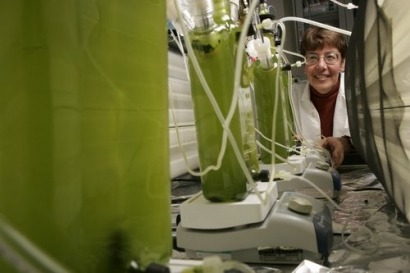
That said, the analysis concludes these concerns are not a definitive barrier for future production.
What's needed, the National Research Council says, are innovations in research and development that help realize algal biofuels' full potential.
The National Research Council is part of the National Academies, a group of private nonprofit institutions that advise government on science, technology and health policy.
Its sustainability assessment was requested by the Department of Energy, which is investing heavily in projects to develop algal-based biofuels as part of the Obama administration's "all-of-the-above" energy policy.
According to the Washington, D.C.-based organization, biofuels derived from algae and cyanobacteria are possible alternatives to petroleum-based fuels and could help the US meet its energy security needs and reduce greenhouse gas emissions, such as carbon dioxide (CO2).
Algal biofuels offer potential advantages over biofuels made from land plants, including algae's ability to grow on non-croplands in cultivation ponds of freshwater, salt water, or wastewater, the group says.
The committee that wrote the report said that concerns related to large-scale algal biofuel development differ depending on the pathways used to produce the fuels. Producing fuels from algae could be done in many ways, including cultivating freshwater or saltwater algae, growing algae in closed photobioreactors or open-pond systems, processing the oils produced by microalgae, or refining all parts of macroalgae.
Key Findings
Sustainable development of algal biofuels would require research, development, and demonstration of the following:
A national assessment of land requirements for algae cultivation that takes into account climatic conditions; freshwater, inland and coastal saline water, and wastewater resources; sources of CO2; and land prices is needed to inform the potential amount of algal biofuels that could be produced economically in the United States.
The committee's sustainability analysis focused on pathways that to date have received active attention. Most of the current development involves growing selected strains of algae in open ponds or closed photobioreactors using various water sources, collecting and extracting the oil from algae or collecting fuel precursors secreted by algae, and then processing the oil into fuel.
The committee pointed out several high-level concerns for large-scale development of algal biofuel, including the relatively large quantity of water required for algae cultivation; magnitude of nutrients, such as nitrogen, phosphorus, and CO2, needed for cultivation; amount of land area necessary to contain the ponds that grow the algae; and uncertainties in greenhouse gas emissions over the production life cycle.
Moreover, the algal biofuel energy return on investment would have to be high, meaning more energy would have to be produced from the biofuels than what is required to cultivate algae and convert them to fuels.
The committee found that to produce the amount of algal biofuel equivalent to 1 liter of gasoline, between 3.15 liters to 3,650 liters of freshwater is required, depending on the production pathway.
Replenishing water lost from evaporation in growing systems is a key driver for use of freshwater in production, the committee said. In addition, water use could be a serious concern in an algal biofuel production system that uses freshwater without recycling the "harvest" water.
To produce 39 billion liters of algal biofuels, 6 million to 15 million metric tons of nitrogen and 1 million to 2 million metric tons of phosphorus would be needed each year if the nutrients are not recycled, the report says.
These requirements represent 44 percent to 107 percent of the total nitrogen use and 20 percent to 51 percent of the total phosphorus use in the U.S. However, recycling nutrients or utilizing wastewater from agricultural or municipal sources could reduce nutrient and energy use, the committee said.
Another resource that could limit the amount of algal biofuels produced is land area and the number of suitable and available sites for algae to grow. Appropriate topography, climate, proximity to water supplies -- whether freshwater, inland saline water, marine water, or wastewater -- and proximity to nutrient supplies would have to be matched carefully to ensure successful and sustainable fuel production and avoid costs and energy consumption for transporting those resources to cultivation facilities.
If the suitable sites for growing algae are near urban or suburban centers or coastal recreation areas, the price of those lands could be prohibitive. A national assessment of land requirements for algae cultivation that takes into account various concerns is needed to inform the potential amount of algal biofuels that could be produced economically in the U.S.
One of the primary motivations for using alternative fuels for transportation is reducing greenhouse gas emissions. However, estimates of greenhouse gas emissions over the life cycle of algal biofuel production span a wide range; some studies suggest that algal biofuel production generates less greenhouse gas emissions than petroleum-based fuels while other studies suggest the opposite. These emissions depend on many factors in the production process, including the amount of energy needed to dewater and harvest algae and the electricity sources used.
The committee emphasized that the crucial aspects to sustainable development are positioning algal growth ponds close to water and nutrient resources and recycling essential resources. With proper management and good engineering designs, other environmental effects could be avoided, the committee said. Examples include releasing harvest water in other bodies of water and creating algal blooms and allowing harvest water to seep into ground water.
For algal biofuels to contribute a significant amount of fuels for transportation in the future, the committee said, research and development would be needed to improve algal strains, test additional strains for desired characteristics, advance the materials and methods for growing and processing algae into fuels, and reduce the energy requirements for multiple stages of production.
To aid the U.S. Department of Energy in its decision-making process regarding sustainable algal biofuel development, the committee proposed a framework that includes an assessment of sustainability throughout the supply chain, a cumulative impact analysis of resource use or environmental effects, and cost-benefit analyses.
For additional information:

